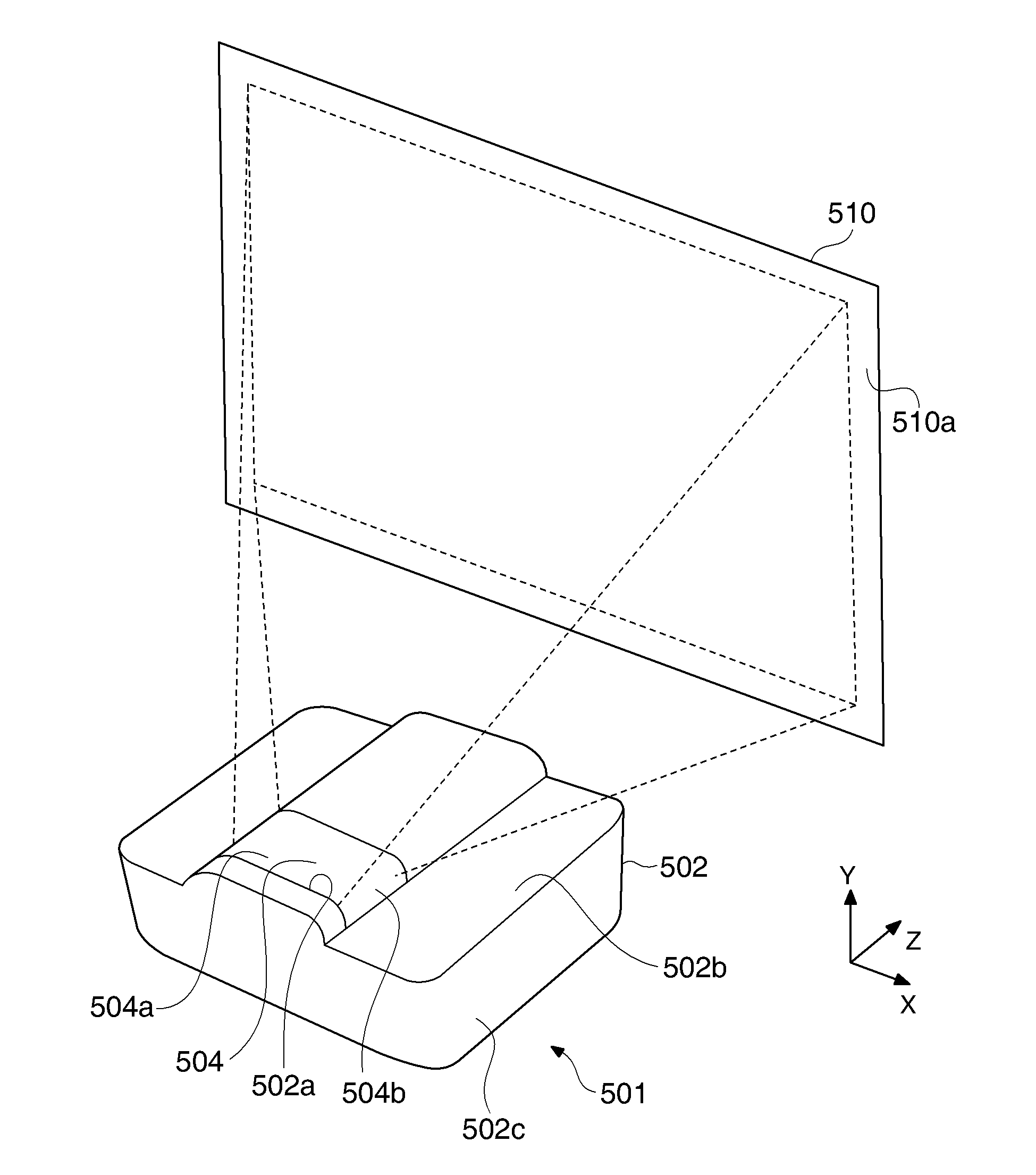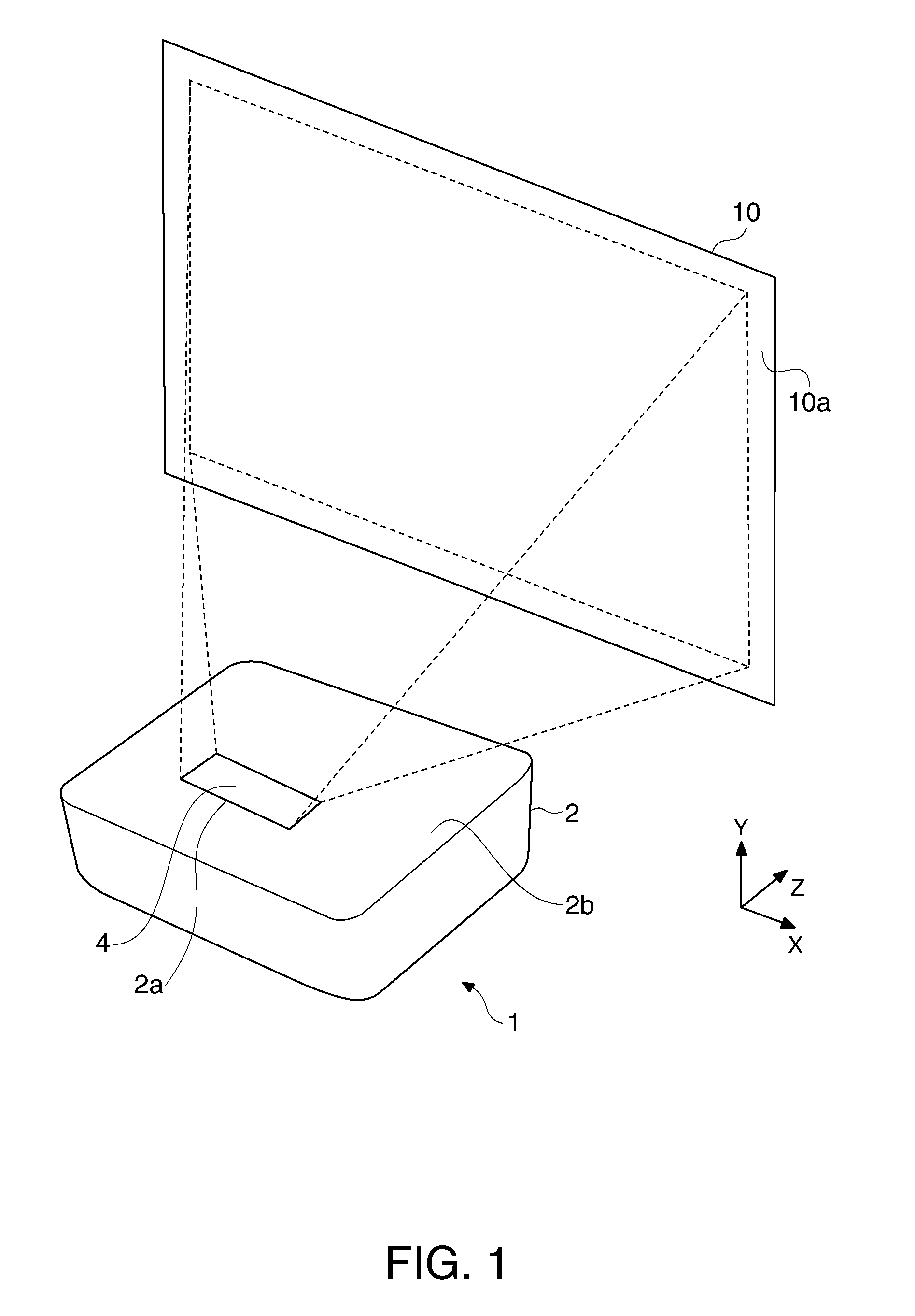Projector
a projector and projector technology, applied in the field of projectors, can solve the problems of significant deformation of the performance of the projection system, increased cost, image brightness reduction, etc., and achieve the effects of reducing manufacturing costs, increasing design freedom, and increasing degree of design freedom
- Summary
- Abstract
- Description
- Claims
- Application Information
AI Technical Summary
Benefits of technology
Problems solved by technology
Method used
Image
Examples
first embodiment
[0065]FIG. 1 is a perspective view showing how a projector according to a first embodiment of the invention is used. FIG. 2 is a transverse cross-sectional view showing a schematic configuration of the interior of the projector. FIG. 3 is a front cross-sectional view but does not show the interior configuration of the projector. The projector 1 is a front projection-type projector that projects projection light on a screen 10 to display an image. A viewer observes the image displayed on the screen 10. The projector 1 is a proximity projection-type projector that is positioned in the vicinity of the screen 10 and projects wide-angle projection light on the screen 10 to display an image.
[0066]The screen 10 is a reflective projection plate and diffuses and reflects the light incident on a front-side screen projection surface (illuminated surface) 10a to display an image. The axis along a normal to the screen projection surface 10a is called a Z axis. The axes perpendicular to the Z axi...
second embodiment
[0104]FIG. 15 is a perspective view showing how a projector according to a second embodiment of the invention is used. FIG. 16 is a transverse cross-sectional view showing a schematic configuration of the interior of the projector. The projector 501 is a front projection-type projector that projects projection light on a screen to display an image. A viewer observes the image displayed on the screen. The projector 501 is a proximity projection-type projector that is positioned in the vicinity of a screen 510 and projects wide-angle projection light on the screen 510 to display an image.
[0105]The screen 510 is a reflective projection plate and diffuses and reflects the light incident on a front-side screen projection surface (illuminated surface) 510a to display an image. The axis along a normal to the screen projection surface 510a is called a Z axis. The axes perpendicular to the Z axis and intersecting each other at right angles are called an X axis and a Y axis.
[0106]The projecto...
third embodiment
[0133]FIG. 24 is an exterior perspective view of a projector 601 according to a third embodiment of the invention. The components that are the same as those in the second embodiment have the same reference characters, and no redundant description thereof will be made. The projector 601 according to the third embodiment is characterized in that the surface of a central portion 604a of a dust-proof cover 604 through which the projection light exits is inclined toward the screen 510. The projector 601 is further characterized in that peripheral portions 604b of the dust-proof cover 604 are bent and inclined to the central portion 604a by 90 degrees.
[0134]FIG. 25 is a partial enlarged view of a reflection optical unit (wide-angle light forming reflector) 630 provided in the projection system 550 of the projector 601. The reflection optical unit 630 includes a curved mirror 631. While the curved mirror 531 described in the second embodiment has a concave shape, the curved mirror 631 in t...
PUM
 Login to View More
Login to View More Abstract
Description
Claims
Application Information
 Login to View More
Login to View More - R&D
- Intellectual Property
- Life Sciences
- Materials
- Tech Scout
- Unparalleled Data Quality
- Higher Quality Content
- 60% Fewer Hallucinations
Browse by: Latest US Patents, China's latest patents, Technical Efficacy Thesaurus, Application Domain, Technology Topic, Popular Technical Reports.
© 2025 PatSnap. All rights reserved.Legal|Privacy policy|Modern Slavery Act Transparency Statement|Sitemap|About US| Contact US: help@patsnap.com



